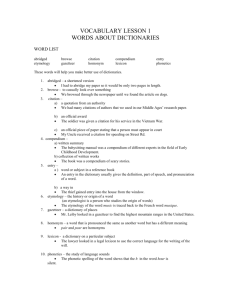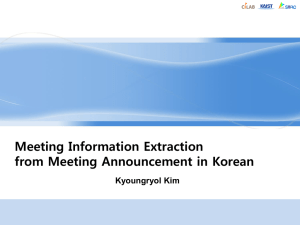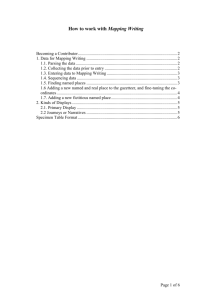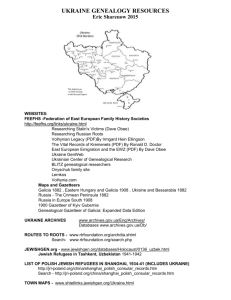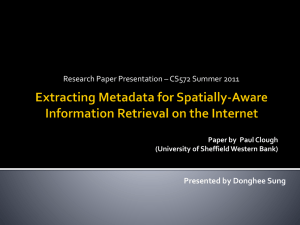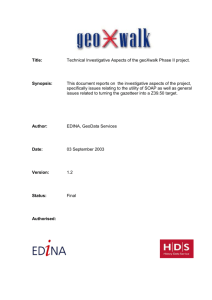Word document - South Hams District Council
advertisement
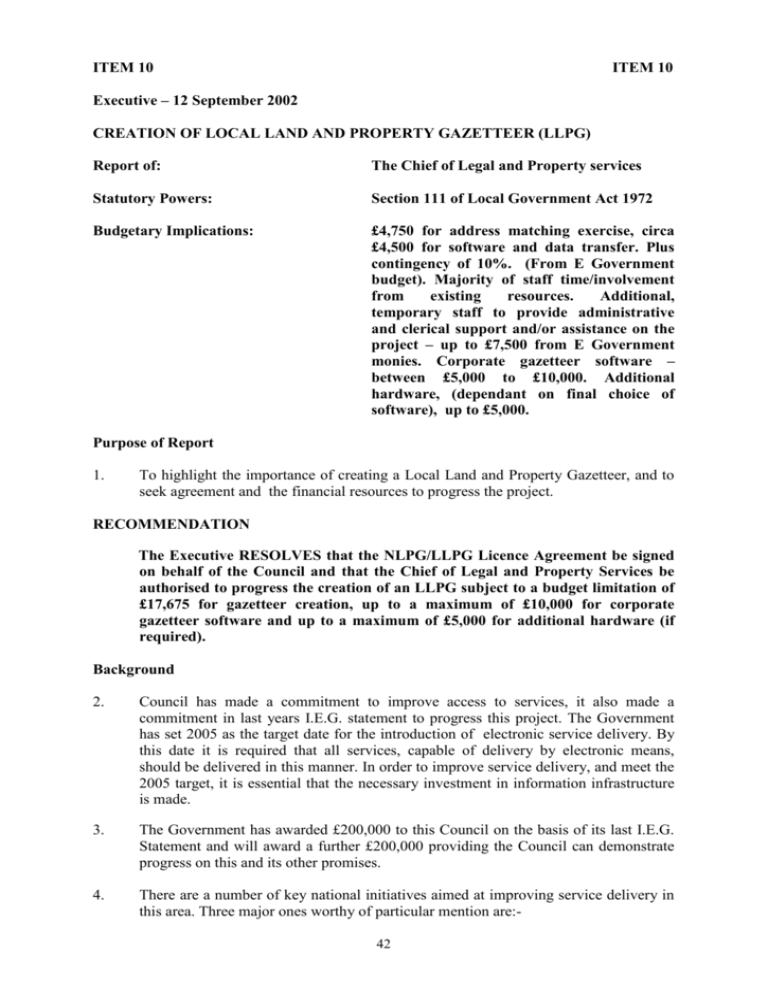
ITEM 10 ITEM 10 Executive – 12 September 2002 CREATION OF LOCAL LAND AND PROPERTY GAZETTEER (LLPG) Report of: The Chief of Legal and Property services Statutory Powers: Section 111 of Local Government Act 1972 Budgetary Implications: £4,750 for address matching exercise, circa £4,500 for software and data transfer. Plus contingency of 10%. (From E Government budget). Majority of staff time/involvement from existing resources. Additional, temporary staff to provide administrative and clerical support and/or assistance on the project – up to £7,500 from E Government monies. Corporate gazetteer software – between £5,000 to £10,000. Additional hardware, (dependant on final choice of software), up to £5,000. Purpose of Report 1. To highlight the importance of creating a Local Land and Property Gazetteer, and to seek agreement and the financial resources to progress the project. RECOMMENDATION The Executive RESOLVES that the NLPG/LLPG Licence Agreement be signed on behalf of the Council and that the Chief of Legal and Property Services be authorised to progress the creation of an LLPG subject to a budget limitation of £17,675 for gazetteer creation, up to a maximum of £10,000 for corporate gazetteer software and up to a maximum of £5,000 for additional hardware (if required). Background 2. Council has made a commitment to improve access to services, it also made a commitment in last years I.E.G. statement to progress this project. The Government has set 2005 as the target date for the introduction of electronic service delivery. By this date it is required that all services, capable of delivery by electronic means, should be delivered in this manner. In order to improve service delivery, and meet the 2005 target, it is essential that the necessary investment in information infrastructure is made. 3. The Government has awarded £200,000 to this Council on the basis of its last I.E.G. Statement and will award a further £200,000 providing the Council can demonstrate progress on this and its other promises. 4. There are a number of key national initiatives aimed at improving service delivery in this area. Three major ones worthy of particular mention are:42 (a) The National Land Information Service (NLIS). Initially this is an electronic Land Charge search service, but in time it is intended that it will become a means of accessing all land or property based information. (b) The Rolling Electoral Register (LASER). The first step towards e-voting, LASER will link together all local electoral registers systems. Built to a common standard data will be managed locally and accessed nationally. People moving between different voting areas will be able to vote in their new constituency almost immediately. (c) National Land Use Database (NLUD) – A national database of derelict sites and other previously used land compiled from information obtained from local authorities. The aim being the re-development of such land before ‘green field’ sites. 5. Before these initiatives, or effective electronic service delivery, can succeed Local Authority data has to be structured correctly and the necessary infrastructure must be in place. 6. The most important infrastructure requirement is a common address database, (built to a British Standard BS 7666), for all property based information. The concept of a National Land and Property Gazetteer (NLPG) has therefore been developed. This national gazetteer will in effect be an amalgamation of Local Land and Property Gazetteers (LLPG) that will be created and maintained by each Local Authority. A draft/embryo NLPG has already been created, (by the Local Government Information House – LGIH, a company wholly owned by the IDeA), for use within the NLIS project. This has been compiled from nationally available datasets and has not had any data cleaning done, it contains inaccuracies, and cannot therefore be considered as definitive. Currently 53% of addresses in the NLPG are maintained by Local Authorities. The LLPG Project 7. Whilst paragraph 4 identifies some national projects it should not be assumed that the creation of a LLPG/NLPG is solely required for these purposes. Rather the creation of the Local Land and Property Gazetteer is an essential building block in the process of joining information/data, and therefore services, together to aid the development and implementation of E Government. It not only enables datasets to relate to one another but facilitates links with external ones too. This is a pre-requisite to a citizen being able to draw information about a particular property without having to worry about where information is stored or indeed who holds it. 8. There are three main drivers to the NLPG initiative: a) Increasing pressure on local authorities to improve the public's perception of their services. Local government interfaces more frequently with the public than other parts of government. In order to improve services, councils have started to implement "one stop shops" in an attempt to resolve enquiries from the public swiftly and efficiently. Not only is customer satisfaction is improved ( there is no bigger “switch off” than being passed from pillar to post) but opportunities are there to make savings by 43 ensuring that work is done at an appropriate level. Virtually all enquiries contain address information. For these enquiries to be dealt with effectively on first contact, each address must be linked to a range of back office databases via a master address list. b) The need to join-up with the wider public sector. Some enquiries, for example benefits applications, need to be linked to services managed by other parts of government. A more widely used master address list can underpin these systems. For example, common referencing would enable data to be exchanged and distributed more economically and accurately between councils, NHS, DWP, Valuation Office, HMLR, Regional planning, DOT, ODPM and the Planning Inspectorate. c) The need to reduce costs to achieve best value Local government is responsible for managing the largest and most diverse portfolio of land and property related information in the United Kingdom and it has been recognized that over 85% of these databases use addresses for referencing. It was also recognized that it is far more efficient to collect a master address list once and share it amongst all users - address-change intelligence frequently being critical to their function (planning, Electoral Roll, Housing, Council Tax, education, social services, environmental health etc). Substantially better and more consistent data and service quality will also result. 9. 10. The complexity and the amount of work required to complete this project should not be under estimated. Essentially however there are three main individual ‘components’ to the project: (a) The National Street Gazetteer – this has been compiled by local highway Authorities (DCC). Originally this was created to assist in the management of street works. It is a component part of the NLPG in that the ‘street’ and ‘town’ fields are drawn directly from the NSG. The first stage is to check and correct this database in consultation with DCC. Some work on this has already been undertaken. (b) Match existing address data – address data from various Council systems (eg Council Tax, N.N.D.R., Electoral Register) have to be matched against other data- sets (Ordnance Survey Address Point, and the current draft/embryo NLPG). From this address matching will come the first draft LLPG. (c) Clean address data – arising from the address matching exercise there will be a percentage of ‘problems’ and mismatches. For example one system might address a property as ‘flat 1’, another might have an address of ‘ground floor flat’; the question to be resolved in this example is, are they one and the same? Once any anomalies have been resolved and a definitive address database has been created with cross references to addresses held in other systems, data can be loaded into a gazetteer maintenance software system. Creating the gazetteer is a somewhat labour intensive process. Checking the street gazetteer is likely to take several weeks. The address matching process can be undertaken by a number of specialist companies. The charge for this service is £4,750 from Intelligent Addressing under an agreement with the IDeA to provide the service 44 to Local Authorities for a fixed price. It is proposed that this company undertake this work. 11. The third part of the process, cleaning address data, is likely to take the longest. Experience at other authorities suggests that the amount of work can vary dramatically, (although a high percentage of the problems seem to originate from problems with the NSG). Sorting these problems will require significant officer time and will need good local knowledge. It is envisaged that existing staff will be involved on this work, although there may be a need for some temporary additional staff to assist with this, or to provide cover for staff directly involved in the project the employment of the equivalent of one person for six months might be necessary and an estimate of cost for this is included in the Budgetary Implications (although this could take the form of two people for three months). 12. The resulting gazetteer would be very much more than a simple database of postal addresses. The ultimate intention is to create a gazetteer that holds an ‘address’ for all areas of land, even fields, waste land, car parks etc. Thus any information that the council holds about any area of land would in turn link to the gazetteer. As well as having a textual entry for each address there would also be a spatial reference. Initially this will only be ‘x’ ‘y’ spatial co-ordinates. Longer term, the extent (polygon) of the property would be included. The gazetteer would therefore be fully integrated into Geographical Information Systems (GIS). 13. It is proposed that initially that gazetteer software from MVM be used to build and hold the first version of the LLPG. The Council already has a BS7666 compliant gazetteer as part of the MVM 20/20 Planning system. Once the LLPG has been created the resulting data would be transferred into Planner 20/20 replacing the Ordnance Survey data that the system currently uses. There would be a charge from MVM of approximately £4,500 to set up a stand alone gazetteer and transfer the resulting data to Planner 20/20. If the Council were to adopt the MVM software as a ‘corporate solution’ there would be an additional charge of (currently) £6,000 for a site licence. There are a number of other companies offering corporate gazetteer software. Costs would obviously vary but are likely to be of a similar amount - (an estimate of between £5,000 and £10,000 is included in the budgetary implications). A final decision on this would be made at the end of the gazetteer creation process and would be based on usual criteria (cost, functionality, compatibility etc.). Corporate implementation could also result in a need for additional/new hardware. This is somewhat dependant on the final choice of software. An estimate of a maximum of £5,000 has been included to cover this eventuality. 14. In order to submit data from our LLPG to the NLPG the Council has to have a licence agreement with the Local Government Information House (LGIH). This is a company wholly owned by the IDeA. The LGIH are the custodians of the national gazetteer and they in turn licence its use to other bodies eg. NLIS. The licence agreement has to be signed before the address matching process can begin as the Council will need access to the draft NLPG. 15. The long term maintenance of the gazetteer is vitally important. The Land Charges section is currently responsible for street naming and numbering and the maintenance of the gazetteer should be seen as part of that statutory function. At this time it is difficult to estimate the effect of maintaining the Gazetteer, however it is likely to result in a net increase in workload for the section, offset in whole or in part by improved working practices. 45 16. Once the gazetteer has been created, it is important that links are in place, and maintained, between it and other Council systems. There are various ways of achieving this, and differing opinions on which way is the best; eg. is it better to update the address automatically from the gazetteer or should the decision be left to the data owners to do it manually? The gazetteer will in any event hold the ‘definitive’ BS7666 address, (linked to a Unique Property Reference Number – UPRN), and hold cross references entries in other databases. Other systems should also hold this UPRN – thus the link to the gazetteer. The best method of maintaining addresses and links to other systems will be decided during the project period. Conclusion 17. The compilation of the LLPG is a fundamental requirement for the provision of effective ‘E Government service delivery’. It is required for the effective operation of the NLIS, electronic conveyancing and the LASER Project. To improve the quality and access of services to the public it is important that data in various systems can link to/or have a reference to a common address database. The LLPG will provide that link. In the future all applications will link to the LLPG. 18. The creation of the LLPG is included in the Council IEG Statement. Failure to make satisfactory progress with this would result in funding for E Government/modernisation projects being withheld. Funding for the creation of the gazetteer would indeed come from the E Government budget. 19. The Council’s legal section has considered the licence agreement, and its implications. Although there are always compromises and inherent risks in partnership working the Local Government Information House operates under the aegis of the IDeA which has been set up specifically to promote the interests of local authorities. It is considered that the risks of not proceeding with signing the agreement and progressing with the work far outweigh the risks of positively embracing it. 20. Background information regarding the National Land and Property Gazetteer and associated projects, obtained from the IDeA website, are included in the appendix accompanying this report. A draft project plan is also attached. G Rowe Chief of Legal and Property Services Executive 12 September 2002 P West Drawing Office Manager Appendices: 1 – Project Plan & timescale, 2 – NLPG within the context of other initiatives, 3 – Background to the project, 4 – How the NLPG/LLPG is produced, 5 – How the NLPG/LLPG will join services and information together 46 APPENDIX 1 LOCAL LAND AND PROPERTY GAZETTEER - Draft PROJECT PLAN OBJECTIVE The ultimate objective is to produce a Local Land and Property Gazetteer (LLPG) to BS7666 standard that can be amalgamated with LLPG’s from other Local Authorities to form the National Land and Property Gazetteer (NLPG). The LLPG to contain a single definitive address for all Land and Property in the District. The LLPG should also contain links/cross references to addresses held in other Council systems and applications. There should be a spatial reference for each entry. Eventually all land in the District would be referenced in the LLPG. ISSUES AND CONSIDERATIONS There are several items which will be considered before, and during, the compilation of the LLPG. In no particular order they are: 1. The National Street Gazetteer (NSG) has been compiled by the highway authorities (in our case Devon County Council). This gazetteer contains information regarding street names, localities and towns – each road should be uniquely held and have a unique street reference number. Any address held within the District Council’s LLPG must link to the NSG entry and contain the NSG street reference number. It is therefore important that all street names, localities and towns are correct in the NSG as the District Council want to see them. 2. Gazetteer software – The Council already has IDeA accredited software from MVM. This is currently used within Planner 20/20 to link addresses (OS Address Point) to planning applications (the same gazetteer would be used by Land Charges 20/20 and Building Control 20/20 systems). The MVM gazetteer will be required for the 20/20 systems. It has not yet been decided whether this will be the corporate gazetteer or whether ‘master data’ will be held in another system and copied back into MVM. 3. MVM 20/20 – The Planning system already links planning applications to a BS7666 gazetteer loaded with O.S. Address Point data. The creation of a new LLPG will in effect “conflict” with the existing links. There appear to be two solutions – either to “un-link” addresses and planning applications or link the new LLPG back to each application. The second option is obviously preferable and may be possible if the Ordnance Survey Address Point Reference will provide the link (an initial conversation with Jon Venn (MVM) suggests that this may be possible). 4. Address Matching – At some stage during the project address data from the Council’s systems (Council Tax, Electoral Register, NNDR – other datasets at extra cost) will need to be matched against each other, the NSG and the existing draft NLPG. There are several companies able to offer this service. The IDeA have an agreement with Intelligent Addressing to undertake address matching for a payment of £4,750. It is suggested that as the IDeA have close links with Intelligent Addressing, and as the NLPG is maintained for the Local Government Information House by Intelligent Addressing, that they undertake the address matching process. 5. NLPG Licence Agreement – As part of the process of developing the NLPG each authority is expected to sign a licence agreement. To date this Authority has not because of concerns regarding the ownership of data and the allocation of revenue that may come from the commercial exploitation of the NLPG. Most of these concerns have now been resolved. ‘Signing up” to the agreement will add impetus and commitment to the project and will open the door for obtaining, much needed, help and assistance from the IDeA and Intelligent Addressing. Signing the agreement is a pre-requisite for obtaining a copy of the draft NLPG which would be needed as part of the address matching process. In effect the LLPG cannot be created unless the agreement is signed. 47 6. Project Team – A project team will need to be set up with the task of compiling the gazetteer. Discussions with other Local Authorities show a wide variation of numbers and time taken to complete the project. A reasonable number would appear to be about 3 or 4. They would need good IT skills and, perhaps more importantly, good levels of local knowledge - someone from IT will be required to look after the various technical issues. The project team would be made up of existing staff. There may however be a requirement to employ one or two temporary staff for short periods to either resolve address problems, or provide cover for staff working on the compilation of the gazetteer. GETTING STARTED As with all projects of any magnitude this is difficult. The steps below suggest the probable route. a) Sign up to the NLPG – to demonstrate commitment and obtain get Draft NLPG data from the Local Government Information House. b) Intelligent Addressing will be commissioned to undertake the address matching exercise. c) Set up a project team/timescales with an overall target of completing the task within a 9 month period. Until a certain amount of work has been undertaken it is difficult to estimate timescale – up to 9 months would seem to be a reasonable target. There may however be pressure from the IDeA to complete in a shorter time period. d) The project team would initially: i) Discuss a proposed methodology with Intelligent Addressing and the IDeA and form a more detailed “plan of campaign”. Agree a specification/standard for BS7666 fields (town, locality etc). ii) Speak to MVM, regarding setting up a separate gazetteer to hold/compile the LLPG and discuss the methodology with them. (Ultimately the LLPG would be integrated with the current MVM 20/20 gazetteer). iii) Clean address information held within the National Street Gazetteer (NSG) – primarily the street, locality and town fields. This work has already been started in advance of the rest of the project. e) Address Matching – Once the data has been “extracted” from the various data bases they will be matched against each other, the NSG and the existing NLPG. (This work to be undertaken by Intelligent Addressing). f) Cleaning up the data – once the data has been matched anomalies, mismatches etc will need to be resolved. This is the time consuming bit, and will be labour intensive. Most of the project time is likely to be spent on this task. (If the street gazetteer has been sorted before the address matching is undertaken the task should be made somewhat easier). There may be a need for additional temporary staffing to assist with this element of the project, or to provide cover for staff involved in the project. g) Data Submission/loading – Once the “problem addresses” etc. have been resolved. The clean, definitive dataset will be returned to Intelligent Addressing to become part of the final NLPG. The Council would thereafter be responsible for the maintenance of the National gazetteer as it applies to the District. This dataset also be transferred to the live 20/20 gazetteer software for linking to Planning/Land Charge/Building control items (this work would be undertaken by MVM) 48 FINAL COMMENT Whilst no one should under estimate this task it has been undertaken successfully by other authorities. The long term benefits should easily outweigh the problems associated with building the database. The success of the project will to a large extent be dependent on being able to put together an enthusiastic project team, and them receiving sufficient support and resources (including time) to complete it. The LLPG will be an essential building block in the move to improve service delivery, integrate systems and implement E Government. Pete West 15 August 2002 49 Appendix 2 NLPG within the context of other initiatives Version 2.0 (NLPG Briefing Notes Pack Sheet 2) Much of the commentary below relating to NLIS and the NLPG has been extracted from the "prospectus – Local Authority electronic service delivery via the National Land Information Service (NLIS) and Scottish Land Information Service (ScotLis)" produced by the IDeA. For further details or copies of the prospectus contact IDeA via the telephone, fax or email addresses given on the page of contacts The National Land Information Service (NLIS) NLIS and its Scottish equivalent ScotLis is an exciting initiative to provide improved access to land and property related information. The overall concept of NLIS/ScotLis is to promote electronic delivery of land and property related information to a wide audience. However, the initial targets are the delivery of integrated land and property information search facilities, which will support the conveyancing process. ScotLis will also be piloting "shopping mall" type access to certain statutory registers and associated information. The overall project is managed by an executive board, chaired by the Chief Land Registrar and comprising representatives from the Improvement and Development Agency (representing local government), HM Land Registry (HMLR), Registers of Scotland (RoS), Ordnance Survey (OS), Department of the Environment, Transport and the Regions (DETR), Valuation Office Agency (VOA) and the Cabinet Office Central IT Unit (CITU). National Land and Property Gazetteer (NLPG) The core of NLIS/ScotLis is the National Land and Property Gazetteer which is itself the aggregation of Local Land and Property Gazetteers (LLPG). The NLPG will provide unambiguous identification of land and property and hence provide access to the information required for the conveyancing process. National Land Use Database (NLUD) The Department of Environment, Transport and the Regions (DETR), working in partnership with English Partnerships, the IDeA and Ordnance Survey (OS), has commenced work on a consistent assessment of Vacant and Derelict Sites and Other Previously Developed Land throughout England that may be available for housing or other development. This will form the first phase of the National Land Use Database (NLUD) that will eventually cover all land uses in England and will be regularly updated. Electoral Roll The aim of the project is to improve the management of information and technology for the Register of Electors and voting. Local Custodians Local Authorities are the definitive source of addresses (street naming and numbering and development control) which are crucial to the effective creation and maintenance of the LLPGs. In this role as Local Custodians of LLPGs, the Local Authorities are the key to the creation and maintenance of the NLPG. BS7666 To facilitate the creation of the NLPG a British Standard (BS7666) has been created. The standard comprises four parts covering Street Gazetteers, Land and Property Gazetteers, Addresses and Rights of Way. An operational BS7666 compliant LLPG is an essential prerequisite for involvement in the NLPG. It should be noted that the creation and maintenance of a BS7666 compliant street gazetteer is already mandatory for all highway authorities. Issues for Local Government Detailed consideration of the role of local authorities in the creation and maintenance of the NLPG and in particular the benefits to be gained and the investment and resources required are detailed in the IDeA prospectus. UK Standard Geographic Base (UKSGB) The aim of the UKSGB initiative is to deliver a service, which will provide electronic access to consistent spatial referencing across the UK. For example, some of the aims of phase 1 of the project are to provide access to definitive administrative names and codes, easy to use administrative area boundaries and definitive postal boundaries. 9 Appendix 3 The IDeA Initiative Version 2.0 (NLPG Briefing Notes Pack Sheet 4) The background IDeA’s subsidiary Local Government Information House Ltd (LGIH) entered a joint venture agreement with Property Intelligence plc (PI). The joint venture means PI’s Intelligent Addressing consultancy unit (IA) will create an embryo National Land and Property Gazetteer from a number of national address datasets which will then be fine tuned with the input from Local Authorities. To assist those Local Authorities who do not yet have a BS7666 compliant Land and Property Gazetteer, Intelligent Addressing are offering a creation service via the IDeA to all Local Authorities. What is going to happen? The embryo NLPG will be created from existing GB-wide datasets such as the Council Tax Lists and Ordnance Survey Address-Point and Intelligent Addressing’s existing commercial property Gazetteer which includes the Non-Domestic Rating Lists. When this first stage is completed, the results will be matched by Intelligent Addressing to address datasets held individually by each Local Authority. The proposal covers four datasets, the Electoral Registers, Address-Point, Council Tax and Non Domestic Rating Lists. This second stage process will clean and synchronise the GB-wide dataset with those of each Local Authority. As the Local Authority’s datasets are matched in turn, they will be returned to each Authority as a BS7666 compliant Gazetteer complete with an official Unique Property Reference Number (UPRN). Part of the data returned will be a cross-reference table linking the Gazetteer to each of the input datasets. One of the elements of a BS7666 compliant land and property gazetteer is a link to the National Street Gazetteer and as part of the creation process, Intelligent Addressing will integrate local copies of the NSG. In addition to the Gazetteer and Cross-Reference data, each Local Authority will be given details of any inconsistencies within the data sets or the Gazetteer and between the Land and Property Gazetteer and the Street Gazetteer. What about those Local Authorities who already have BS7666 compliant Gazetteers? Although a formal structure for the NLPG maintenance hub is still under discussion, Intelligent Addressing will create a fully functioning hub to allow all existing and newly created LLPGs to be fully integrated into the NLPG. This hub will also allow the continual movement and integration of all changes, additions and deletions from Local to National Gazetteers. Will there be anything left for a Local Authority to do? Yes, Intelligent Addressing can help in the initial bulk processing of address based data and can create a BS7666 LLPG for any Local Authority, but the Local Authority will have to commit time and resources to checking, cleaning and maintenance, see Gazetteer Creation Why are Intelligent Addressing involved? From their experience as part of the leading supplier of property information, the Intelligent Addressing team long ago recognised the possible benefits in terms of data quality, reduced administration and collection costs and, indeed, increased revenue that a gazetteer could bring. To this end IA have already created the only commercial property gazetteer with national coverage for their own internal use. However, the full benefit to the wider property industry and the country as a whole can only be achieved if a truly complete, nationally accepted, constantly maintained and easily available NLPG is brought into existence. Through the IDeA initiative this ambition will be realised. 10 Appendix 4 & 5 Stage 2 - Creation of Local Land & Property Gazetteers (LLPG) Electoral Roll Non-Domestic Rates BS7666 Format BS7666 Format + + Council Tax BS7666 Format Address-Point /own co-ordinates BS7666 Format Other datasets BS7666 Format Draft LLPG + + Compared to Draft NLPG version All exceptions resolved by LA UPRN reference to populate Original files Final LLPG (replaces draft version nationally Local maintenance commences) Appendix 4 - How the NLPG/LLPG is produced (Source IDeA) Appendix 5 - How the NLPG/LLPG will join information and services together (Source IDeA) 11
